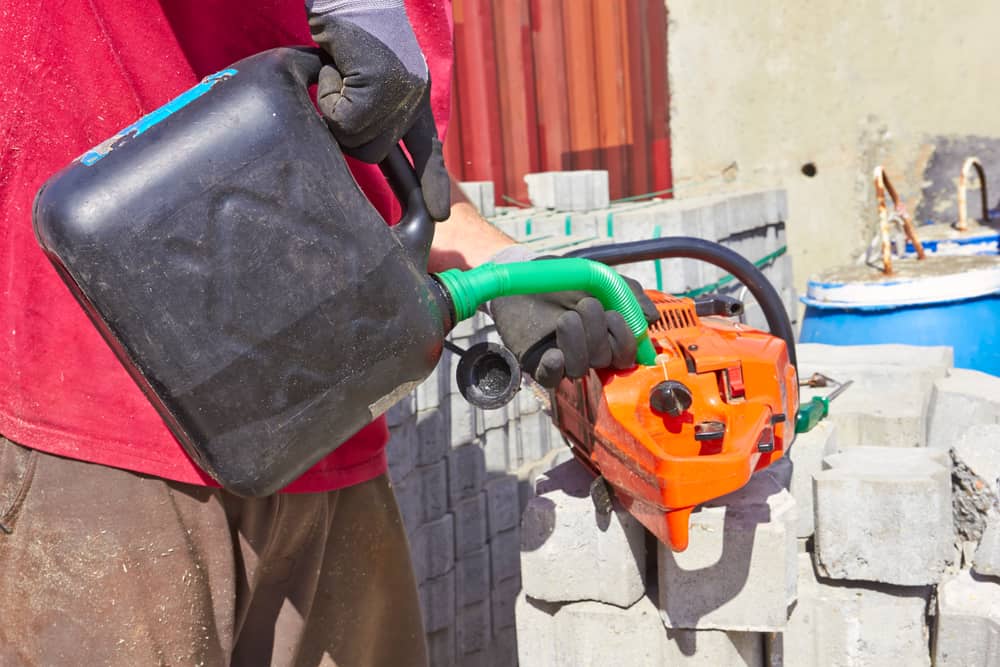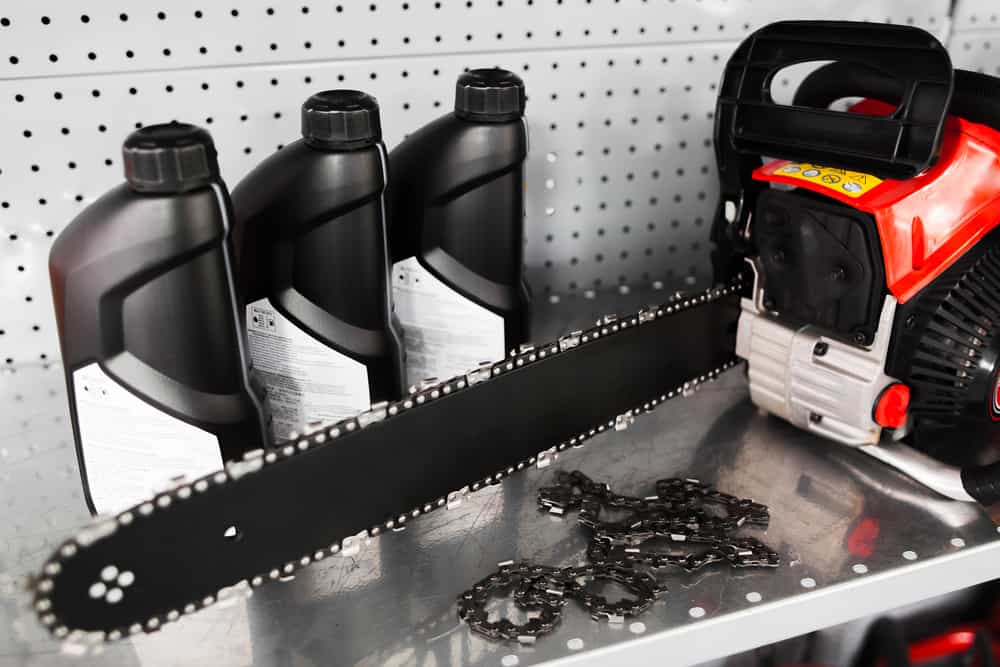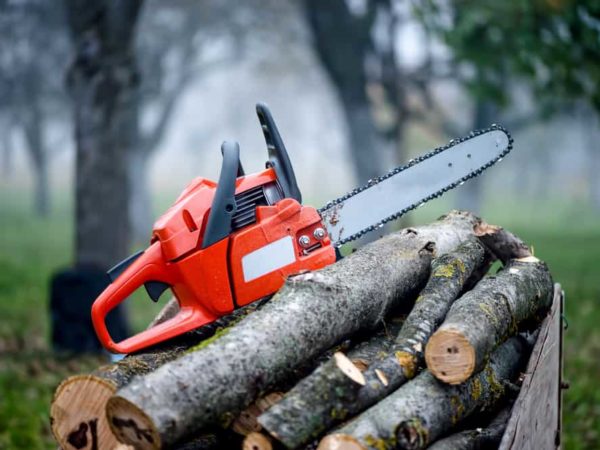Chainsaws can be expensive machines, and if you own one, you are sure to want to keep it in good working order. If you have a gas-powered one, part of this will mean always using the correct fuel – and since most chainsaws are 2-stroke models, this will involve mixing up the right gas-and-oil mix.
What is the correct gas to oil ratio for chainsaws? Why do you need to mix gas and oil like this? And what happens if you don’t? Here, we have the answers to these questions and more to help you keep your chainsaw running the way you want it to.
If you want a quick preview of some of the stuff we’re going to be talking about, check out this video that introduces some of the main concepts.
Table of Contents
2-stroke vs 4-stroke – what’s the difference?
Before we get into mixing oil for your chainsaw’s fuel tank, let’s take a step back and think about why we need to do this at all.
Chainsaw engines come as either 2-stroke or 4-stroke versions. Sometimes these are also referred to as 2-cycle and 4-cycle engines – it’s the same thing.
Without going deep into the mechanics of how chainsaw engines work, a 2-stroke engine produces power for every two strokes of the pistons while a 4-stroke engine requires four strokes to produce power.
In a 4-stroke engine, on the third stroke, oil is taken from a special oil reservoir and brought into the engine to lubricate it. Since there is a separate oil reservoir and a stroke dedicated to lubrication, there is no need to mix oil into the gas the engine runs on.
However, in a 2-stroke engine, this doesn’t happen. There is no separate oil reservoir and there is no stroke dedicated to the lubrication of the engine – and for this reason, to keep a 2-stroke engine running smoothly, oil needs to be added to the fuel.
What is the Correct Gas to Oil Mix for Chainsaws?
There is no standard oil-to-gas ratio across engines, and you will need to check the manual for your particular chainsaw. However, most 2-stroke chainsaw engines, as well as any other similar power tools, run on a mixture that is one part oil to 50 parts gas, 1:50
However, many run on a ratio of 1:40, and other optimum ratios are possible – this is why it is essential to check the requirements of your machine.
So what does this look like in practice? Just to give an example, a 1:50 ratio of oil to gas works out at 2½oz of oil to each gallon of gas.
When you make your oil-and-gas mixture, take care to measure the amounts as precisely as possible. If you don’t get it right, you can easily end up damaging the engine of your chainsaw.
However, having said that, if you do make a mistake, it is better to have a little bit too much oil than not enough, so if in doubt, you can be slightly generous when adding the oil to the mix.
And what happens if you forget to add oil to the fuel you put in your chainsaw? You will know about it very quickly. The engine will start smoking within less than a minute and if you don’t shut it off immediately, it is likely to suffer irreparable damage.
How to make a gas and oil mix
If you have a chainsaw with a 2-stroke engine, you can easily mix up your own gas-and-oil blend to use as fuel. There’s no special technique, and all you’ll need is a gas can and something to measure the volumes.
First, pour the required amount of gas into the gas can. Carefully measure out the required amount of oil and pour it in after. Close the cap on the gas can and give the whole thing a good shake to make sure the gas and oil are properly mixed.
You can now use the mixture in your gas can to fill up your chainsaw.
General tips about gas engines
- Give your chainsaw a shake if it hasn’t been used for a while
If your chainsaw hasn’t been used for a while – say, for a couple of weeks but less than a month – give the whole thing a good shake before you fire it up. If you leave it sitting, the gas and oil will separate it, and shaking the chainsaw will ensure they are well mixed before you start it.
- If it sits for more than a month, replace the fuel
If you don’t use your chainsaw for more than a month, empty the fuel and refill it with fresh fuel. Gasoline doesn’t age well, and after a month it will begin deteriorating to the point where the chainsaw no longer functions correctly. If you try to use old fuel, you risk damaging your chainsaw’s engine.
- Buy premixed fuel for convenience
If you don’t want to mix gas and oil yourself, you can buy premixed fuel to save yourself the hassle. If you do, make sure you choose one that is suitable for your machine.
- Don’t use an oil mix in a 4-stroke engine
Make sure you know what kind of engine your chainsaw has. If it is a 2-stroke engine and you forget the oil, you will damage the engine. However, if you have a 4-stroke engine, you should make sure you only use pure gas – otherwise, you will also risk damaging your expensive chainsaw.
- Add oil for chain lubrication
Quite separately from engine oil, chainsaws need oil for chain lubrication. This is true of gas-powered versions as well as electric chainsaws and cordless chainsaws. Make sure you don’t forget to lubricate the chain.
Always use the right ratio
As we said, while the most common oil-to-gas ratios are 1:50 or 1:40, there is no standard, so you shouldn’t just guess. Make sure you find out exactly what ratio your chainsaw’s engine requires and mix it up carefully and precisely. Similarly – and this goes without saying – make sure you know whether you are running a 2-stroke engine or 4-stroke engine before filling the tank and firing it up.
Chainsaws are expensive tools, and failing to use the right oil-and-gas mix – or pure gasoline in the case of a 4-stroke engine – is the quickest way to send you valuable machine straight to the scrapyard.
Don’t forget to pin it!

















